The Ultimate Guide to Product-Led Growth
Rohan Rao
Dec 12, 2024
Introduction
Product-led growth (PLG) has emerged as a hot topic in the business world, capturing the attention of entrepreneurs, marketers, and product managers alike. This innovative growth strategy puts the product at the center of customer acquisition and retention, leveraging the product as the primary driver of growth. As more companies recognize the potential of PLG to drive sustainable growth and customer loyalty, it has become increasingly important to understand what PLG is, how it works, and how to implement it effectively.
In this comprehensive blog post, we will dive deep into the world of Product-Led Growth, providing a detailed guide on everything you need to know about this powerful growth strategy. We will start by defining PLG and exploring its key principles, then move on to real-world examples of companies successfully implementing PLG. We will also discuss building a PLG strategy, including frameworks and tactics for marketing, onboarding, and user experience. Additionally, we will cover the essential metrics and KPIs for measuring the success of your PLG efforts, as well as recommended tools and resources for implementing PLG in your organization. By the end of this post, you will have a comprehensive understanding of PLG and be well-equipped to leverage this growth strategy in your business.
What is Product-Led Growth?
Product-led growth is a go-to-market strategy that relies on the product as the primary driver of customer acquisition, conversion, and retention. In a PLG model, the product is designed to be easily discoverable, accessible, and valuable to users, creating a frictionless user experience that encourages adoption and loyalty. This differs from traditional sales-led or marketing-led growth models, which rely heavily on outbound sales and marketing efforts to drive customer acquisition and growth.
The importance of adopting a PLG strategy lies in its ability to drive sustainable, scalable growth by leveraging the power of the product itself. By creating an inherently valuable and easy-to-use product, companies can reduce their reliance on costly sales and marketing efforts and instead focus on building a loyal user base that advocates for the product and drives organic growth. Additionally, PLG can help companies understand better and serve their customers by collecting data on user behavior and preferences directly within the product.
Discover how to create successful products that meet customer needs and drive business growth. In our ultimate guide, master product development and learn the essential stages, best practices, and future trends in product development.
Key Principles of Product-Led Growth
At its core, Product-Led Growth is guided by key principles prioritizing the user experience and the product’s ability to drive growth. These principles include:
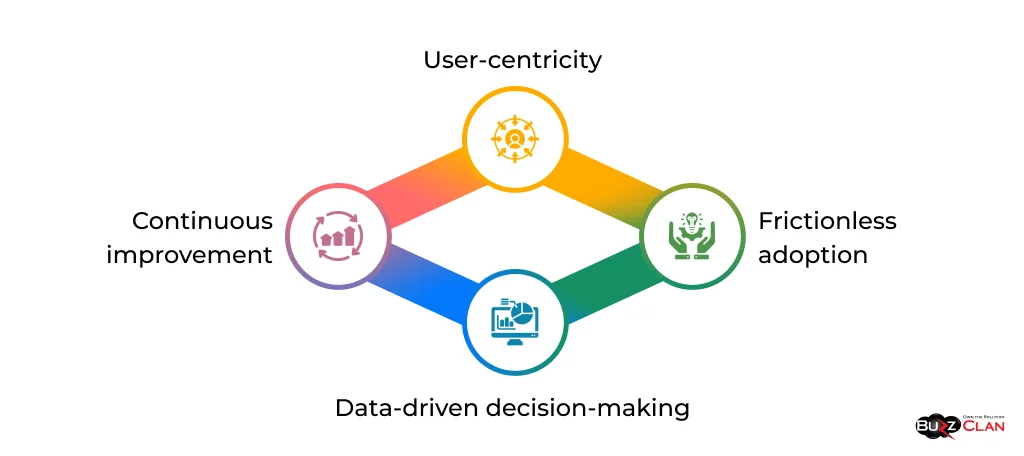
- User-centricity: PLG puts the user at the center of the growth strategy, focusing on creating a product that solves real user problems and delivers value quickly and easily.
- Frictionless adoption: PLG seeks to reduce barriers to adoption by making the product easily discoverable, accessible, and valuable to users from their first interaction.
- Data-driven decision-making: PLG relies heavily on data and analytics to understand user behavior, preferences, and needs and to make informed decisions about product development and growth strategies.
- Continuous improvement: PLG is an iterative process that continuously gathers user feedback, analyzes data, and improves the product and user experience.
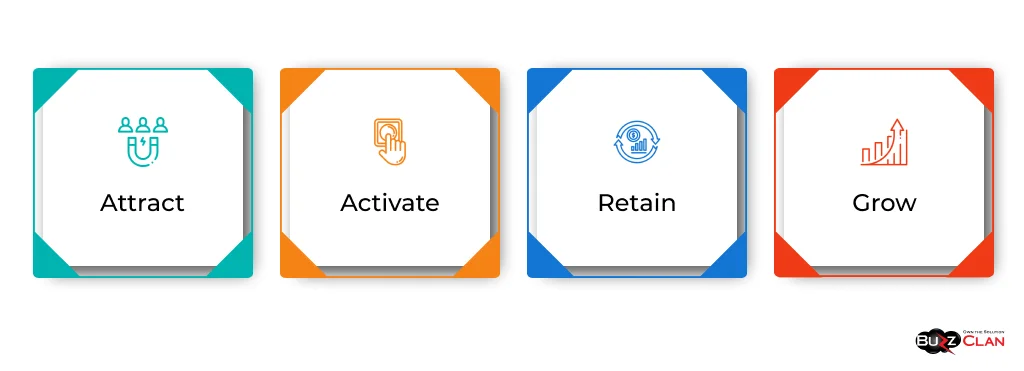
Central to the PLG methodology is the concept of the PLG flywheel, which illustrates how the product, user experience, and growth strategies work together to drive sustainable growth. The flywheel typically includes four key stages: Attract, Activate, Retain, and Grow. By optimizing each stage, companies can create a virtuous growth cycle that builds long-term momentum.
Examples of Product-Led Growth
To better understand how PLG works, look at real-world examples of companies successfully implementing PLG strategies.
- Slack: Slack is a messaging and collaboration platform that has become ubiquitous in business. Slack’s PLG strategy relies on a freemium model that allows users to easily sign up and start using the product for free, with the option to upgrade to paid plans for additional features and functionality. By making the product easily accessible and valuable, Slack has driven rapid adoption and growth, with over 12 million daily active users as of 2021.
- Dropbox: Dropbox is a cloud storage and file-sharing platform that has also leveraged PLG to drive growth. Like Slack, Dropbox uses a freemium model that allows users to easily sign up and start using the product for free, with the option to upgrade for additional storage and features. Dropbox has also invested heavily in creating a seamless user experience, with features like automatic syncing and easy file sharing that make the product inherently valuable to users.
- Zoom: Zoom is a video conferencing platform that has seen explosive growth recently, particularly during the COVID-19 pandemic. Zoom’s PLG strategy relies on a free product version that allows users to quickly sign up and start hosting video meetings, with the option to upgrade for additional features and functionality. By making the product easily accessible and valuable from the start, Zoom has been able to drive rapid adoption and become a household name in the video conferencing space.
These examples demonstrate the power of PLG to drive sustainable, scalable growth by leveraging the product itself as the primary driver of customer acquisition and retention.
Building a Product-Led Growth Strategy
Developing a successful Product-Led Growth strategy requires a systematic approach that puts the user at the center of the growth process. Here are the key steps involved in building a PLG strategy:
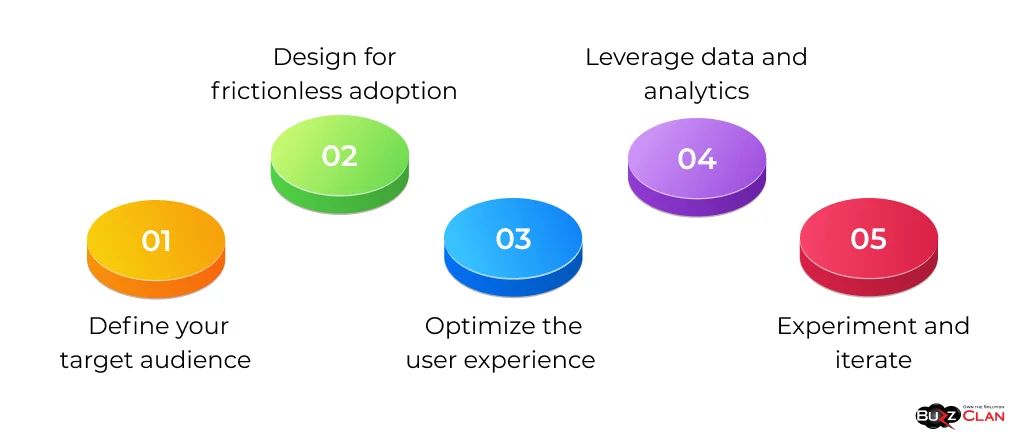
- Define your target audience: Identify your ideal customer profile and understand their needs, pain points, and preferences.
- Design for frictionless adoption: Create a product that is easy to discover, sign up for, and start using, focusing on delivering value quickly and easily.
- Optimize the user experience: Continuously gather user feedback and data to identify areas for improvement in the user experience and make iterative changes to optimize the product for adoption and retention.
- Leverage data and analytics: Use data and analytics to understand user behavior, preferences, and needs and to make informed decisions about product development and growth strategies.
- Experiment and iterate: Continuously experiment with different growth tactics and strategies, measure their impact, and iterate based on the results.
Companies can also leverage established PLG frameworks to help guide the development of a PLG strategy. One popular framework is the Product-Led Growth Flywheel, which breaks down the growth process into four key stages: Attract, Activate, Retain, and Grow. By optimizing each flywheel stage, companies can create a virtuous growth cycle that builds long-term momentum.
Another useful framework is the Product-Led Growth Maturity Model, which outlines the key capabilities and milestones companies must achieve to implement a PLG strategy successfully. The model includes five maturity levels, from Initial to Optimized, and guides the key focus areas at each level, such as user experience, data and analytics, and growth experimentation.
Product-Led Growth in Marketing
Product-led growth requires shifting traditional marketing strategies, focusing on leveraging the product as the primary driver of customer acquisition and growth. Here are some key PLG marketing tactics that companies can use:
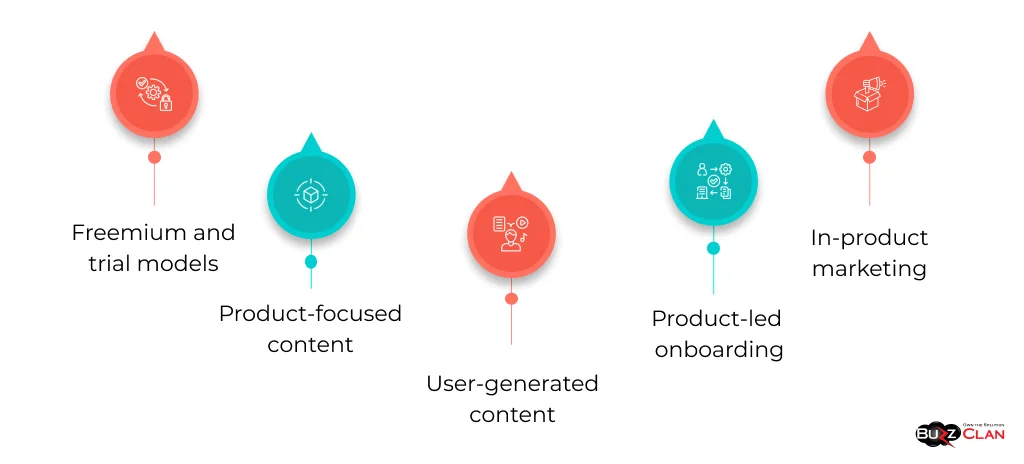
- Freemium and trial models: Offering a free version of the product or a free trial period can be an effective way to drive initial adoption and allow users to experience the product’s value firsthand.
- Product-focused content: Creating content that showcases the product’s features, benefits, and use cases can help attract and engage potential users and drive adoption.
- User-generated content: Encouraging users to create and share content about their experience with the product can be a powerful way to build social proof and drive word-of-mouth referrals.
- Product-led onboarding: Designing an onboarding experience focused on helping users quickly realize the product’s value can effectively drive activation and retention.
- In-product marketing: Leveraging in-product messaging and prompts to encourage users to upgrade to paid plans or try new features can effectively drive growth within the product.
Onboarding and User Experience
In a Product-Led Growth model, the user experience is critical to driving adoption and retention. One of the most important aspects of the user experience is the onboarding process, which is users’ first interaction with the product. A well-designed onboarding process can help users quickly understand the product’s value and encourage them to continue using it over time.
To create an effective onboarding process, companies should focus on the following best practices:
- Keep it simple: The onboarding process should focus on helping users quickly achieve their goals with the product.
- Personalize the experience: Using data and user segmentation to personalize the onboarding experience can help to increase engagement and retention.
- Provide clear guidance: Offering clear instructions throughout the onboarding process can help users quickly understand how to use the product and realize its value.
- Celebrate success: Celebrating users’ success and progress with the product can be a powerful way to encourage continued engagement and adoption.
Beyond onboarding, companies should continuously optimize the user experience to drive adoption and retention. This can involve gathering user feedback and data to identify areas for improvement, conducting user research and testing to validate design decisions, and making iterative changes to the product to optimize for user engagement and satisfaction.
Metrics and KPIs for Product-Led Growth
Measuring the success of a product-led growth strategy requires a different set of metrics and KPIs from traditional sales-led or marketing-led growth models. Here are some of the key metrics that companies should track to measure the success of their PLG efforts:
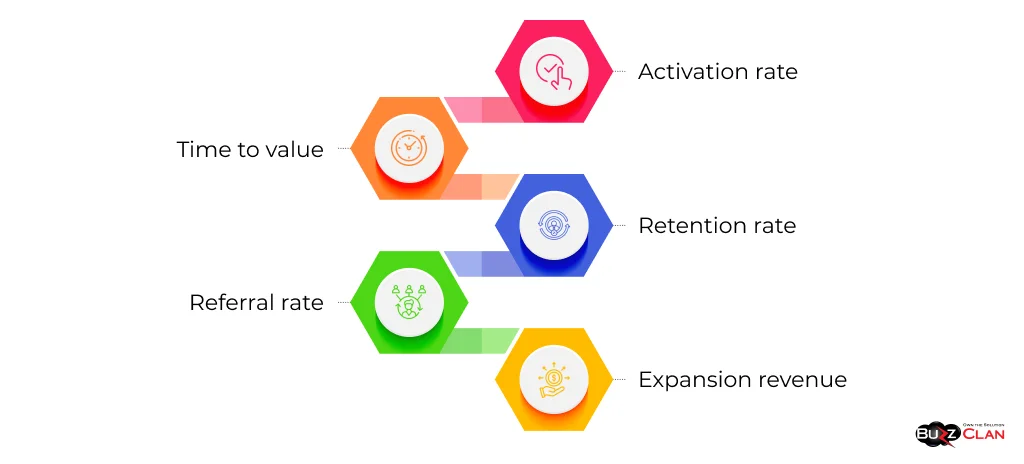
- Activation rate: The percentage of users who complete a key action or milestone within the product, such as creating an account or completing a specific task.
- Time to value: Users realize the product’s value and achieve their desired outcome.
- Retention rate: The percentage of users who continue using the product over a specific period, such as 30 or 90 days.
- Referral rate: The percentage of users who refer others to the product through word-of-mouth or formal referral programs.
- Expansion revenue: The additional revenue generated from existing users, either through upgrades to paid plans or by purchasing additional features or services.
By tracking these metrics and using them to inform product development and growth strategies, companies can optimize their PLG efforts and drive sustainable, scalable growth over time.
Tools and Resources for Implementing Product-Led Growth
Implementing a successful Product-Led Growth strategy requires various tools and resources to support product development, user experience design, data analysis, and growth experimentation. Here are some recommended resources for companies looking to implement PLG:
Books and Reading Materials:
- “Product-Led Growth: How to Build a Product That Sells Itself” by Wes Bush
- “Mastering Product Experience in SaaS” by Nick Bonfiglio
- “Obviously Awesome: How to Nail Product Positioning so Customers Get It, Buy It, Love It” by April Dunford
Software and Tools:
- Pendo: A product analytics and user engagement platform that helps companies understand user behavior and optimize the user experience.
- Mixpanel: A product analytics platform that provides insights into user behavior and engagement.
- Intercom: A customer messaging platform that supports product-led onboarding and user engagement.
- UserVoice: A user feedback and product management platform that helps companies gather and prioritize user feedback and feature requests.
Product-Led Growth for SaaS Companies
While Product-Led Growth can be applied to various industries and business models, it is particularly well-suited to software-as-a-service (SaaS) companies. SaaS companies typically have a low barrier to entry, with products that are easily accessible and valuable to users from the start. Additionally, SaaS companies often have access to rich data on user behavior and preferences, which can be used to inform product development and growth strategies.
To leverage PLG effectively, SaaS companies should focus on the following key areas:
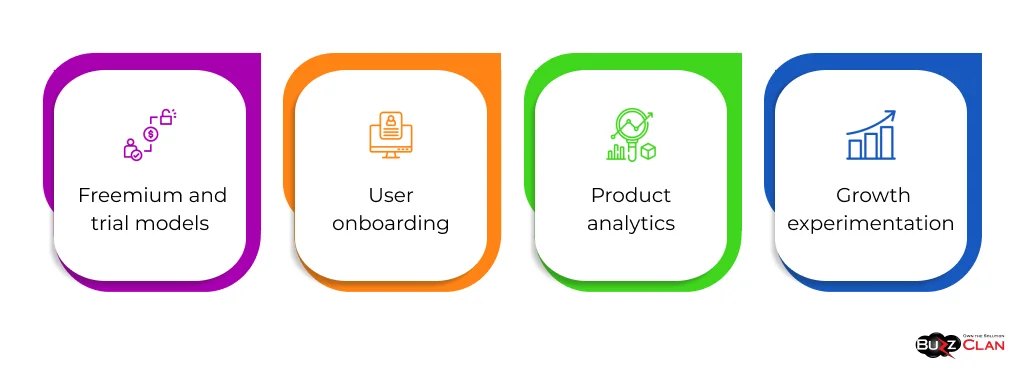
- Freemium and trial models: Offering a free version of the product or a free trial period can be an effective way to drive initial adoption and allow users to experience the product’s value firsthand.
- User onboarding: Designing a practical onboarding experience that helps users quickly understand the product’s value and achieve their desired outcomes can be critical to driving activation and retention.
- Product analytics: Understanding user behavior, preferences, and needs can help SaaS companies make informed decisions about product development and growth strategies.
- Growth experimentation: Continuously experimenting with different growth tactics and strategies, such as in-product messaging, referral programs, and pricing models, can help SaaS companies optimize their PLG efforts over time.
Challenges and Pitfalls in Product-Led Growth
While Product-Led Growth can be a powerful strategy for driving sustainable, scalable growth, it has its challenges and pitfalls. Here are some of the most common challenges that companies face when implementing PLG:
- Balancing free and paid users: Offering a free version of the product can be an effective way to drive initial adoption, but it can also create challenges in converting users to paid plans and generating revenue.
- Maintaining product quality: As the user base grows, product quality and performance can become increasingly challenging, mainly if the product is not designed to scale effectively.
- Managing user feedback: Gathering and prioritizing user feedback can be time-consuming and resource-intensive, mainly as the user base grows and becomes more diverse.
- Aligning product and growth teams: Ensuring that product development and growth teams are aligned and working towards a common goal can be challenging, particularly if competing priorities or conflicting metrics exist.
To avoid these pitfalls, companies should focus on the following strategies:
- Clearly define the value proposition: Ensure that the product’s value proposition is clearly defined and communicated to users and that the free version provides enough value to encourage adoption and retention.
- Invest in scalable infrastructure: Ensure the product is built on a scalable infrastructure that can handle growth and maintain performance as the user base expands.
- Prioritize user feedback: Develop a systematic process for gathering, prioritizing, and acting on user feedback and ensure the product team is closely aligned with users’ needs and preferences.
- Align metrics and incentives: Ensure that product development and growth teams are aligned around a common set of metrics and incentives and that these metrics are closely tied to the business’s overall goals.
Conclusion
Throughout this blog post, we have explored the fundamental principles and tactics of Product-Led Growth, including user-centric design, frictionless adoption, data-driven decision-making, and continuous experimentation and iteration. We have also looked at real-world examples of companies that have successfully implemented PLG strategies and discussed the key metrics and resources that companies can use to measure and optimize their PLG efforts.
As the business landscape continues to evolve and become increasingly competitive, Product-Led Growth is likely to become an increasingly important strategy for companies looking to drive growth and build sustainable, scalable businesses. By putting the user at the center of the growth process and leveraging the power of the product itself, companies can create a virtuous cycle of growth that builds momentum over time and drives long-term success.
FAQs

Get In Touch
